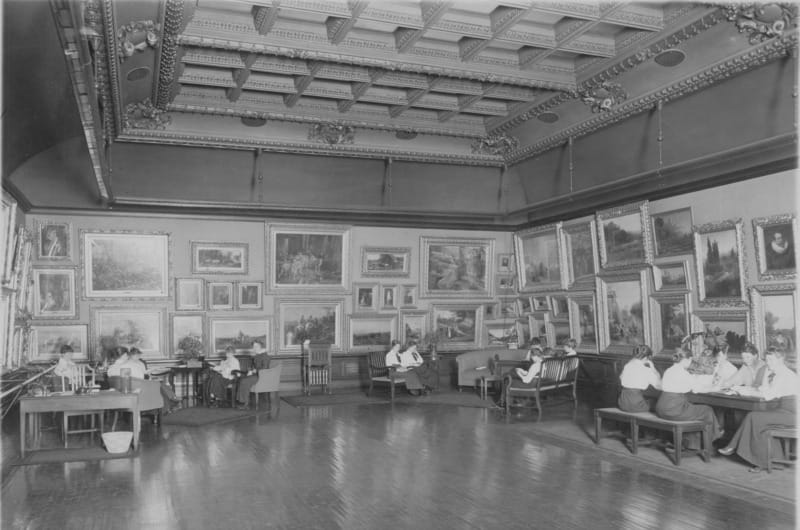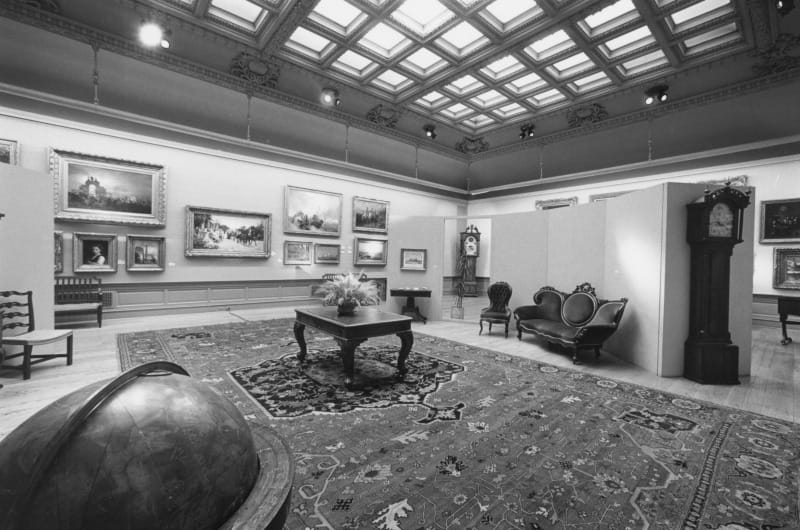A.J. Drexel Picture Gallery Gets a Retro Makeover

If you’ve visited the A. J. Drexel Picture Gallery recently, you might have noticed that the paintings have been completely rearranged and there are somehow more of them. If you had visited the A. J. Drexel Picture Gallery in 1902, when it first opened, the view would look pretty similar, more or less.
That’s because earlier this month there was a homecoming of sorts for over 30 paintings from The Drexel Collection that returned to the A. J. Drexel Picture Gallery after spending the past 15 or so years hanging in the Paul Peck Alumni Center. That space will now feature rotating exhibits, starting with Howard Pyle, His Students & the Golden Age of American Illustration in April.
With the return of those paintings, as well as the completion of over 50 conservation treatments of other pieces of art, Lynn Clouser, director of The Drexel Collection, has completely rearranged the gallery to better reflect the space’s historical identity.
“It’s fitting that this redesign is occurring during Drexel’s 125th anniversary year,” said Clouser. “These plans for the picture gallery had been in place since 1892 but were put on hold until a space was created to hold the art outside of the original Drexel Museum on the first floor of Main Building.”
To pay homage to the early days of the institute, Clouser pored over historical photos of the space, interviewed alumni from Drexel’s home economics department, which frequently used the space many decades ago, and worked with Charles Morscheck, PhD, a professor in the art history department of the Antoniette Westphal College of Media Arts & Design. Morscheck has taught at Drexel since 1976 and served as the steward of The Drexel Collection in the ‘90s during a transitional period between curators.
Visitors will see that not only are there new — and more — paintings in the space, which was last changed in 2002, but that the art is now displayed in a completely different way. Before, the art was shown in a traditional “single hang” style featuring rows of paintings hung at eye level. Now, the paintings are in a salon-style hang, which means that large groupings of art are hung higher and lower on the wall to take up more space.
“The salon-style hang, which originated in the salons of pre-Revolutionary France, really highlighted all of our offerings,” said Clouser. “In fact, a lot of the pieces that we have would have been found in these salons, because they’re mostly 19th century European art. And this is a style of hanging art that would have still been popular at the turn of the 20th century when these paintings would have been hung at the Drexel Institute of Art, Science and Industry.”
Most of the 85 pieces of art currently in the space have been part of The Drexel Collection since the University was founded in 1891 or in the decade or so afterward. The room is mostly a collection of the personal art of three men closely tied to the institute or its founding family. For example, University founder Anthony J. Drexel died in 1893 and bequeathed his art collection to the institute. When George W. Childs, his lifelong friend, business partner and successor as president of the board of trustees, died a year later, the institute received his art as well as collections of literary manuscripts and autographs (later sold in the 1940s). The institute also received his watches and clocks, including the David Rittenhouse 18th century Astronomical Musical Clock located in the A. J. Picture Gallery.
The last major benefactor, John D. Lankenau, a brother-in-law of the founder and namesake of Lankenau Medical Center, bequeathed 58 paintings to Drexel in 1901 to fulfill a decades-long pact he had made with Anthony in 1884. When Lankenau needed funding to expand the German Hospital of the City of Philadelphia, which was later renamed in his honor, Anthony agreed to donate money if Lankenau would will his art collection to the institute Drexel was already planning on establishing. When Lankenau died, he did exactly that.

Anthony and Lankenau’s personal art collections vary greatly — a fact made even more apparent now that Anthony’s art has been returned from the Paul Peck Alumni Center and is hung next to the Lankenau paintings on the south wall of the gallery. Anthony collected more vernacular paintings, which feature people depicted in day-to-day scenes; he donated one of the Collection’s better-known paintings, Julius L. Stewart’s “After the Wedding,” which depicts two newlyweds (rumored to be Anthony’s daughter and Stewart’s brother) riding off to their honeymoon. Lankenau, on the other hand, mostly collected landscape paintings, such as those done by well-known artists like Jean-Baptiste Camille Corot, Barbizon School artists and Düsseldorf Academy artists.
“It’s so interesting to see the two different collections side-by-side,” said Clouser. “Both Anthony and Lankenau are from the same time period, the same city and the same wealth, more or less, but their tastes in art were so different. People did collect what they like back then and that’s something that is still encouraged these days.”
The Drexel family is also prominent on the north wall of the gallery, where paintings of various Drexel descendants as well as those from Anthony’s lifetime (including his father, artist-turned-banker Francis Martin Drexel) are now grouped together. The Drexel Collection holds the largest accumulation of Francis Martin paintings, mostly donated by members of the Drexel family, and displays other paintings of Drexel family members on the west wall of the gallery.

On the east wall, portraits and paintings depicting the 18th century are hung to compliment the Rittenhouse clock, built it 1773, standing before it.
Now that the gallery’s walls look completely different, a new interpretive plan is needed to guide tours and offer information about the art to visitors. Kelly Bishop, a senior specializing in the visual arts in Westphal’s entertainment and arts management program, will develop the plan for her senior project. Bishop, who previously worked for The Drexel Collection as a co-op, will also add content to the Collection’s website, plan a mini opening event with Morsheck later this spring and design interactive activities for visitors, such as a scavenger hunt using photos of art that hung in Anthony’s house and early photos of the gallery.
Even beyond the paintings, the gallery itself maintains aspects of its original state, including red fabric on the walls, ebony-colored wainscoting outlining the room and brass pendant lamps descending from ceiling's gilded molding. It’s all part of the plan to encourage viewers to step back in time when they enter the room — and take a break from the intensive studying and hustle-and-bustle of campus life by soaking up art, history and culture.
In This Article
Drexel News is produced by
University Marketing and Communications.

